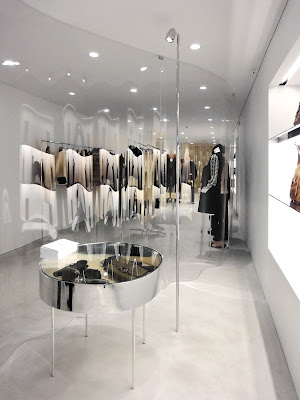Derek Lam's second SANAA-designed store opened in UES last Friday in conjunction with New York Fashion Week. Similar to the first one in SoHo, the store uses transparent acrylic walls to divide the space into zones for different collections. But this time, instead of individual bubbles, the acrylic panels form a continuous surface that wraps around and constantly alters the notion of inside and outside. This surface is not just a simple extrusion of a planar curve, but a drape-like loft with a smooth curve on top and a more ripply one at the bottom.
The effects are unique and stunning. (Good job, Jack!) And it all started with a very pragmatic consideration. In the first store, the acrylic is too transparent. Many people bumped into it when they were not paying enough attention. In this new design, the architects tried to make the acrylic wall more visible. Then the ripples make sense. The denser they get, the more multiplicity of reflections they create, and the more apparent they will look. The surface also gets more ripply at places where it needs to be structurally strengthened. (Same rationale as the Vakko slumped glass.)
It is also a less expensive manufacturing process. Instead of building giant molds to form the different curvatures, this free-form surface only requires a profile of the top curve and a profile of the bottom. Then the whole panel was cramped and put into the oven vertically. It's a relatively easy process and you don't need to worry about modularization or repetition in order to save money.
Learning from the past is golden. But in our time of big egos, it has become a lost practice. Very few people would look back and admit that they could have done better, not mentioning to express regret for their mistakes. How can you improve if you already think you are the king of the world?








1 comment:
the metaphorical material was developed to be thinner in this case.
Post a Comment